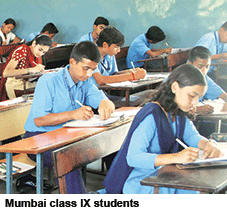 Maharashtra (pop. 114 million), India’s most industrialised state, is all set to introduce a new statewide common exam to improve the learning outcomes of 1.7 million class IX children in the 21,000 secondary schools affiliated with the Maharashtra State Board of Secondary and Higher Secondary Education (MSBSHSE). This proposal was mooted at a meeting of officials of the education department and Maharashtra State Council of Educational Research and Training in Pune on June 4.
Maharashtra (pop. 114 million), India’s most industrialised state, is all set to introduce a new statewide common exam to improve the learning outcomes of 1.7 million class IX children in the 21,000 secondary schools affiliated with the Maharashtra State Board of Secondary and Higher Secondary Education (MSBSHSE). This proposal was mooted at a meeting of officials of the education department and Maharashtra State Council of Educational Research and Training in Pune on June 4.
Under the proposal, MSBSHSE, which has hitherto been testing and certifying school-leaving class X and XII students, will also set class IX papers for all subjects. However, although MSBSHSE will set the class IX common question papers, the exams will be conducted by affiliated schools which will also evaluate students’ answer papers.
“Schools aren’t doing proper objective evaluation of class IX students resulting in an average of 10 percent being detained as they are adjudged unprepared to write the class X board exam in the following year. But, almost half these detained students are able to pass the class X exam when they write it privately. We want to prepare class IX question papers to enable schools to objectively judge which students are likely to pass or fail,” says Nand Kumar, Maharashtra state education secretary.
Private school principals and managements say that only a small minority of schools — 2-3 percent — unwarrantedly detain students and education officials should pull them up rather than impose another common exam on students and schools. In any event, the promotions policy guidelines of the education ministry make it difficult for schools to fail/detain class IX students.
“Government guidelines encourage schools to award grace marks and use the ‘combined passing’ format which allows students with below pass mark scores in some subjects to combine scores across six subjects to get a pass marks average,” says Achama Mathew, CEO of Bombay Cambridge Gurukul, which runs five state board-affiliated schools with an aggregate enrolment of 9,074 students.
Adds Nikhat Jafferey, principal of Mumbai-based Hansraj Morarji Public School: “The root cause of poor class IX and X exam results is the no-detention in classes I-VIII provision of the Right of Children to Free & Compulsory Education (RTE) Act, 2009.”
Quite clearly, the rationale of introducing a common test for all class IX children in MSBSHSE-affiliated schools is to prepare students to do well in the board’s class X and XII public exams. In 2015-16, the pass percentage of students writing MSBSHSE’s class X exam dipped to 89.56 percent from 91.46 percent in 2014-15. Another reason is to improve the image of MSBSHSE.
In NCERT’s National Achievement Survey (NAS) 2015, which measured the real learning outcomes and cognitive skills of a representative sample of class X students of schools affiliated with 33 school examination boards including the CISCE and CBSE, MSBSHSE school students failed (below 50 percent) in four (English, maths, science and social science) subjects. They passed only in major Indian language (Marathi) with a score of 62 percent.
Based on NAS 2015 data, EducationWorld ranks MSBSHSE India’s #5 school examination board below not only CISCE and CBSE, but also the examination boards of Goa, West Bengal and Mizoram (see EW June 2016 cover story). Hardly a satisfactory ranking for the school exams board of India’s most industrialised state.
Dipta Joshi (Mumbai)